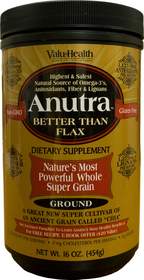Contact Information: Media Contact: Amy Summers 727-848-1618 ext. 202 Pitch Inc.
Ancient Super Seed Rediscovered
Once You Kick the Flax Habit You May Never Go Back
| Source: Anutra Farms
ORLANDO, FL--(Marketwire - June 19, 2008) - The Aztecs regarded it as the third most
important crop behind corn and beans but today few people know about the
health secrets behind chia.
There's a new super cultivar of the ancient chia (Salvia hispanica L.)
grain called Anutra that may replace Westerners' "flax" mentality.
"Anutra is a new multi-colored cultivar of Salvia hispanica L. and has 25
percent more protein, twice the calcium, 25 times more lignans than flax
and more antioxidants than flax or cultivated blueberries," says Angelo S.
Morini, author of "Anutra: Nature's Best Kept Secret and World's Healthiest
Whole Food" (ValuHealth, 2008). "There are so many reasons to replace flax
with Anutra. I wrote the book to help Americans rediscover this ancient
super food that has been overlooked for so many years."
Although flax has received quite a bit of fanfare over the past several
years, it does have its nutritional roadblocks. First, flax is not
strictly regulated by the Food and Drug Administration (FDA) and is not
regarded as a food. According to a published report by the Mayo Clinic,
evidence supporting flax health claims is unclear. According to the Flax
Council of Canada, flax can cause life-threatening reactions in an
unbalanced diet due to its cyanogenic compounds. Low protein diets with
little methionine and cystine and toxins from whole flax may cause vitamin
B and thyroid interruptions.
Some of these safety concerns may make Anutra, the chia Salvia hispanica L.
grain, more attractive to health-conscious consumers. It is classified by
the FDA as a regular food with an established history of safe consumption.
It is a 100 percent natural, non-GMO, gluten-free, raw whole grain that is
grown without the use of pesticides. Five grams of Anutra also has a
thousand milligrams of omega-3, making it an excellent source of omega-3
based on the FDA's guidelines.
"The primary use for flax in this country is to manufacture industrial
products such as coatings, floor coverings, paints and varnishes," says
Morini. "Somewhere along the way Americans have been misguided on the holy
grail for grains. When I show people the benefits of Anutra and how easy
it is to incorporate in an existing diet, most people never go back to
flax."
Morini's book outlines the health benefits of Anutra and gives recipes for
some favorite entrees that have been "AnutraSized" as he coins it and
includes a 90-day diet that will regenerate cells to slow the normal aging
process. By adding in the Anutra grain you can change the nutritional
destiny of some of your favorite meals. And different than flax, Anutra
has a neutral taste that takes on the flavors of the food and doesn't
overpower. For more Anutra recipe ideas and nutritional information visit:
http://www.anutra.com or Amazon.com to order the book.
